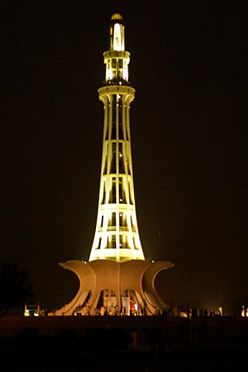- Minar-e-Pakistan
-
Minar-e-Pakistan 
General information Status National Tower of Pakistan Type Public monument Location Lahore, Pakistan Coordinates 31°35′33″N 74°18′34″E / 31.5925°N 74.30944°ECoordinates: 31°35′33″N 74°18′34″E / 31.5925°N 74.30944°E Construction started 1960 Completed 1968 Height Roof 62 metres (203 ft) Design and construction Main contractor Mian Abdul Khaliq Company Architect Naseer-ud-din Murat Khan Structural engineer Abdur Rehman Khan Niazi Minar-e-Pakistan is a tall minaret in Iqbal Park Lahore, built in commemoration of the Lahore Resolution. The minaret reflects a blend of Mughal and modern architecture, and is constructed on the site where on March 23, 1940, seven years before the formation of Pakistan, the Muslim League passed the Pakistan Resolution (Qarardad-e-Pakistan), demanding the creation of Pakistan.[1] This was the first official declaration to establish a separate homeland for the Muslims living in the Indian Subcontinent.[2] Interestingly, the site is also where Nehru and the Indian National Congress declared Indian independence from Britain in 1929.[citation needed])
The monument attracts visitors from all over Pakistan, as well as the inhabitants of the Walled City of Lahore. The large public space around the monument is commonly used for political and public meetings, whereas Iqbal Park area is popular among kite-flyers.
Contents
Design
The tower was designed and supervised free of cost by Nasreddin Murat-Khan,an architect/engineer hailing from Daghestan. The design approved by the President was built by Mian Abdul Khaliq and Company. The foundation stone was laid on March 23, 1960. The construction took eight years of time, and was completed in 1968. The Minar was completed on 31 October 1968 at an estimated cost of Rs. 500,000. The money was collected by imposing additional tax on the cinema and horse racing tickets on the demand of governor of west Pakistan akhtar hussain. Today, the minaret provides a panoramic view to visitors who can climb up the stairs or through an elevator. The parks around the monument include marble fountains and an artificial lake.
Structure
The base is about 8 meters above the ground. The tower rises about 62 meters on the base, thus the total height of minaret is about 92 meters above the ground. The unfolding petals of the flower-like base are 9 meters high. The diameter of the tower is about 9.75 m, and marble. The rostrum is built of patterned tiles, and faces the Badshahi Mosque. The base comprises four platforms. To symbolise humble beginnings of the freedom struggle, first platform is built with uncut Taxila stones, second platform is made of hammer-dressed stones, whereas third platform is of chiselled stones. Polished white marble at the fourth and final platform depicts the success of the Pakistan Movement.[3] Mr. Mukhtar Masood a prolific writer and the then deputy commissioner of Lahore was one of the many commissioners heading the Building Committee.
Inscriptions
At the base, there are floral inscriptions on ten converging white marble Commemorative plaques. The inscriptions include the text of Lahore Resolution in Urdu, Bengali and English, and Delhi Resolution’s text, which was passed on April 9, 1946. On different plaques, Quranic verses and 99 attributes of God are inscribed in Arabic calligraphy, whereas National Anthem of Pakistan in Urdu and Bengali, excerpts from the speeches of Muhammad Ali Jinnah, in Urdu, Bengali and English, as well as few couplets of Allama Iqbal are inscribed.[3]
The Pakistan Resolution was passed in 23 March 1940 in Iqbal Park where minar e Pakistan is located.
Concerns
With the growth of the city and location of the monument at busy intersection of Circular Road and Multan Road, air pollution from traffic-congestion is continuously damaging the marble structure which is now in need of refurbishment.
The top of the Minar-e-Pakistan has been closed to the public to deter suicides by people jumping from the top.[4] As of 2005, at least 26 people had committed suicide by jumping from the minaret.[5][6] The artificial lake around the monument is also reported to be a suicide spot.[4]
Gathering
The greatest gathering of people at Minar-e-Pakistan was on 30th October, 2011. More than Five Hundred Thousand people came in rally of Pakistan Thareek-e-Insaf (PTI) led by Imran Khan gathering an growing avalanche of support fueling a possibly successful revolution in Pakistan.[citation needed]
References
- ^ Christophe Jaffrelot (2002) A History of Pakistan and Its Origins. Athens Press. 326 pages. ISBN 1843311496
- ^ Ian Talbot (1998) Pakistan: A Modern History. St. Martin's Press. 450 pages. ISBN 0312216068
- ^ a b Amna Jamal (2002) The Pakistan Day memorial. DAWN. 23 March. Retrieved on 12 February 2008
- ^ a b "Nuggets from the Urdu press". The Friday Times, Vol. XXIII, No. 30. 2011-09-09. http://www.thefridaytimes.com/beta2/tft/article.php?issue=20110909&page=14.
- ^ "Suicide spot: PHA will inspect Minar-e-Pakistan to install railing". Daily Times. 2005-07-09. http://www.dailytimes.com.pk/default.asp?page=story_9-7-2005_pg7_16. Retrieved 2011-09-09.
- ^ "Official transferred to CM House commits suicide". Daily Times. 2004-10-29. http://www.dailytimes.com.pk/default.asp?page=story_29-10-2004_pg7_20. Retrieved 2011-09-09.
External links
- http://archnet.org/library/sites/one-site.tcl?site_id=364
- http://www.lahore.com/content/section/4/45/
- View from space (Google Maps)
Lahore topics History Origins • Etymology • Hindu rule • Muhammadan period • Mughal rule • Sikh rule • British rule • Lahore Resolution • 1965 War • Lahore DeclarationGeography Economy Stock market • Water supply and sanitation • Transport • Health care • Education • Tallest buildings • Sister citiesCulture Architecture • Cinema • Cuisine • Festivals • Language • Music • People • Religion • Shopping • SportsPlaces National symbols of Pakistan Categories:- Articles to be expanded with sources
- Architecture of Lahore
- Buildings and structures in Lahore
- Islamic architecture
- Monuments and memorials in Pakistan
- National symbols of Pakistan
- Pakistani architecture
- Towers in Pakistan
- Visitor attractions in Lahore
Wikimedia Foundation. 2010.
